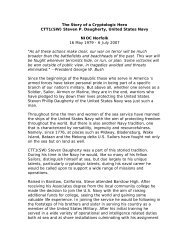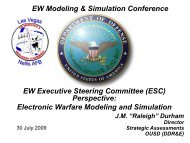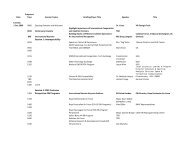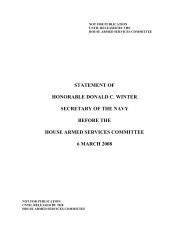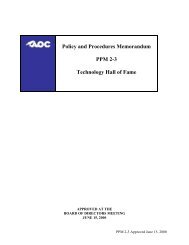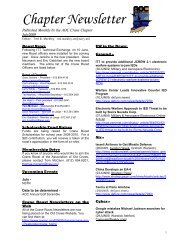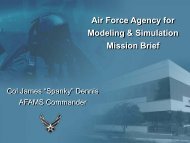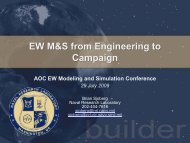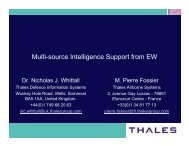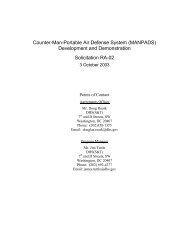Air Force Electronic Warfare Evaluation Simulator (AFEWES)
Air Force Electronic Warfare Evaluation Simulator (AFEWES)
Air Force Electronic Warfare Evaluation Simulator (AFEWES)
Create successful ePaper yourself
Turn your PDF publications into a flip-book with our unique Google optimized e-Paper software.
<strong>Air</strong> <strong>Force</strong><strong>Electronic</strong> <strong>Warfare</strong><strong>Evaluation</strong> <strong>Simulator</strong>(<strong>AFEWES</strong>)Presented byLt Col Seth D. Shepherd, USAF
Organization / Location<strong>AFEWES</strong> reports to the 412 th TestWing/<strong>Electronic</strong> <strong>Warfare</strong>Directorate. The 412 th Test Wing ispart of the <strong>Air</strong> <strong>Force</strong> Flight TestCenter, Edwards <strong>Air</strong> <strong>Force</strong> Base,California. The <strong>AFEWES</strong> facility islocated at <strong>Air</strong> <strong>Force</strong> Plant 4 in FortWorth, Texas.<strong>AFEWES</strong> is a Government-ownedContractor-operated test facility.Lockheed-Martin AeronauticsCompany currently operates andmaintains the <strong>AFEWES</strong> facility.Contact Information:Fort Worth:412 TW/OL-ABAF Plant 4, Box 371, MZ-1100Ft. Worth TX 76101-0371(817) 763-4856 DSN 838-5856Edwards <strong>Air</strong> <strong>Force</strong> Base:412 TW/EW31 Hoglan AvenueEdwards <strong>Air</strong> <strong>Force</strong> Base CA 93524(661) 275-7610 DSN 525-7610AFFTC<strong>AFEWES</strong>
<strong>AFEWES</strong> Mission<strong>AFEWES</strong> Supports U.S. and Allied Governments’ Questfor Increasing <strong>Air</strong>craft Survivability• <strong>AFEWES</strong> performseffectiveness and/orintegration testing ofelectronic warfaresystems and techniquesin a simulated Infrared(IR) and Radio Frequency(RF) threat environment.• <strong>AFEWES</strong> test capabilitiesenable understanding ofaircraft versus threatsystem engagements. EWsystem effectiveness isused to supportacquisition, employment,and tactics decisions forUS and allied armedforces.
<strong>AFEWES</strong> Threat Simulations<strong>AFEWES</strong> develops and operateshigh-fidelity Hardware-in-the-Loop(HITL) RF and IR simulations ofSurface-to-<strong>Air</strong> (SAM) and <strong>Air</strong>-to-<strong>Air</strong>(AAM) missiles.A vigorous, systematic Verification &Validation (V&V) process is ongoingto quantify the fidelity and accuracyof all <strong>AFEWES</strong> RF and IR threatsimulations. This process isoverseen by an IPTrepresenting Intelligence Centers,Government Laboratories,Developmental and Operational TestAgencies, and Threat Experts fromacross DoD.The intent of this V&V process is toensure that <strong>AFEWES</strong> simulationsare credible and appropriate fordetermining EW systemeffectiveness.High-fidelity RF simulations ofessentially all semi-active RF SAMswhich pose a threat to US and alliedaircraft:• Classic Semi-Active Guidance• Seeker-Aided Ground Guidance(SAGG)High-fidelity IR simulations of most IRthreats faced by US and allied aircraft:• Red and Gray MANPADS• IR <strong>Air</strong>-to-<strong>Air</strong> Missiles• Vehicle-Mounted IR SAMs
EW Systems/Techniques Evaluated<strong>AFEWES</strong> simulations support evaluation of severaldifferent types of electronic warfare equipment suchas:• Onboard RF Jammers• Towed Decoys• Radar Warning Receivers• Self-Protect Chaff• Integrated RWR & Countermeasures• <strong>Air</strong>craft Maneuvers• Lamp and LASER IR Jammers• Conventional, Thrusted, and AerodynamicFlares<strong>AFEWES</strong> testing is appropriate throughout theacquisition cycle from initial concept, throughdevelopmental and operational test and evaluation,operational deployment, to evaluation of hardwareupgrades and assessing performance against theevolving threat.<strong>Evaluation</strong>s are made using actual US or allied EWsystem hardware or appropriate surrogate models orsimulators.Testing is accomplished at real-time, actualfrequency/wavelength in a highly instrumented, realtimeenvironment supporting fully dynamicengagements. <strong>AFEWES</strong> offers same-day test dataavailability and is certified as HLA compliant.
<strong>AFEWES</strong> Simulation Precise Vector GeometryAccurate vector geometry isnecessary to understand IR and RFengagement outcomes. The vectorseparation between the missile andtarget as well as the orientation ofeach are accurately representedthroughout the weapon fly-out. Aprimary result of the simulation isthe determination of vector missilemiss distance. Miss distance isessential to understanding theengagement outcome -- a criticalpart of assessing EW systemeffectiveness and aircraftsurvivability.Flight characteristics of each<strong>AFEWES</strong> threat simulation arerepresented with a 6 degree-offreedom(6-DOF) real-time fly-outmodel developed in closecoordination with US intelligenceagencies.
<strong>AFEWES</strong> RF System Testing<strong>AFEWES</strong> Testing EvaluatesReceiver Discrimination andTransmitted EW TechniqueEffectiveness utilizing threeclasses of RF testing.Closed-Loop T&E– Two-way path from threat toEW system and EW system tothreat– Defensive countermeasurestestingOpen-Loop T&E– One-way path from threatsimulation to EC System– Receiver / ProcessorTestingCombined Open & Closed-LoopT&E– Individual threats embeddedin complex, distributed RFlaydowns– Dense environment EWsystem effectiveness
RF Open-Loop System TestingRF/MMWReceiverUnder Test<strong>AFEWES</strong> offers a versatile, realisticdense RF environment. Testing ofRF/Millimeter Wave (MMW)receivers, Radar Warning Receivers,and the receiver processors of ECMsystems, is accomplished using theMultiple Emitter Generator (MEG).The MEG can generate realisticallydense, theaterspecificemitter laydowns with a onehalfsecond scenario update rate. Avast array of scenarioinstrumentation options is available.Seventy-three (73) dedicatedinstantaneous sources/emitters areprovided with up to 20 complexwaveform (PD) sources. Multiplexingexpands this capability to 217emitters of hostile, neutral, andfriendly signals.RF coverage is available from 0.5 to18.0 GHz, 30 to 40 GHz, and 90 to100 GHz amplitude AOA only. Ifrequired, the National Imagery andMapping Agency-based terrainmasking effects can also beincluded..<strong>Air</strong>borne Emitters
RF Closed-Loop System Testing<strong>AFEWES</strong> RF Closed-Loop threatsimulations are based on aniterative, real-time solution of theradar range equation, based on theaircraft and missile flight paths.Databases representing the radarcross section (RCS) of the victimaircraft, the transmit and receiveantenna patterncharacteristics of the System UnderTest (SUT), and threat antennacharacteristics provide inputs tosimulation.Actual EW systems can be placed in asecure shield room and interfaced to. the <strong>AFEWES</strong> threat simulationsthrough RF wave guides.Alternately, the JammEr Techniques<strong>Simulator</strong> (JETS) is used togenerate certain classes of EWwaveforms if actual equipment isunavailable.Simulation Attributes Provide Engagement Fidelitywith High Throughput (100+ runs/day)Rear Reference Direct RaySeeker ClutterRear Reference Clutter‣ TTR‣ Clutter‣ Target Signature‣ EC System‣ Seeker‣ Missile / target• OAR or Digital• Terrain, site-specific, generic,JEM• All Aspect RCS(scintillation/glint)• SUT or simulated• Angle/Doppler track loop• High fidelity antenna patterns• Guidance computer• Real-time flight kinematics
RF Combined Open andClosed-Loop System TestingEW system effectiveness is afunction of battlefield environment.<strong>AFEWES</strong> offers high fidelity threatsimbedded in dense RF/MMWenvironment. Some RF ECM systemscontain receivers, signal processing,and transmitter systems to:1. detect the hostile threatenvironment,2. identify and prioritize detectedthreat systems,3. allocate available jammingresources to the highest prioritythreats, and4. activate defensivecountermeasures.<strong>AFEWES</strong> evaluates these systemswith imbedded closed-loop highfidelityRFSAMs in an spatially distributed, realfrequency emitter laydown.Combined open and closed-loop testand evaluation enableseffectiveness assessment of theoverall EC system in a realisticallystressing dense RF environment.Decoy<strong>Air</strong>borne Emitters
• Some advanced RFSAMs employ aspecialized guidanceprinciple known asSeeker-AidedGround Guidance(SAGG). The SAGGguidance techniquecombines semiactiveseeker inputswithin the trackingloop, which is closedin the ground-basedguidance computer,not in the airborneseeker as would bethe case in a puresemi-active missile.• To address theeffectiveness of EWtechniques againstthese advancedsystems, <strong>AFEWES</strong>and an OAR arepursuing non-realtimeinterfacetechniques tointegrate simulatedradar and missileseeker information tosupport T&Emethods appropriateto evaluate EWtechniques againstthese advancedsystems.TargetSeekerDownlinkBeaconAIR<strong>AFEWES</strong> RF DirectionTERRadar TrackingFunctionTargetReceiverProcessorMissileReceiverProcessorAcquisitionRadarTargetTrackAlgorithmsMissileTrackAlgorithmsGuidance ComputerMissile Tracking and Guidance FunctionGROUNDMissileLaunch/TrackMissileGuidance/SeekerControlAntennaPointingMissilePrep DataUp-linkCommands
Integrated OAR-HITL ConceptThe OAR PieceThe HITL PieceTerrain DataRadar Data•Track History•Mode Words•Launch Solution<strong>Air</strong>craft Data•Position & Velocity•Attitude•ECM Data•Power•ModesInterfaceControlDocument(ICD)ECM Mode/PowerSUTICDDatafrom OARECM RF WaveformGround Radar DataTerrainDataJEM, Glint,Scintillation<strong>Air</strong>craft DataClutter<strong>Simulator</strong>RFGeneratorHITLMissileSimulationGuidanceComputerRF SceneRESULTDigitalMissileFlyoutTarget RCSAntenna PatternsRadome EffectsIntegratedEngagementsMultiple Launches* Locations * TimesVectorMiss DistanceTest missions will be flown on an OAR. Time correlateddata from these OAR flights will then be brought into theHITL facility in an Interface Control Document (ICD)format. The data is fed into the HITL to enablerepresentation of the functions of the radar illuminator,clutter, electronic warfare system modes and timing,target aircraft time-space-position information (TSPI)during OAR flight. This information, alongwith target radar cross section, antenna pattern information,jammer waveforms and timing, as well as other relevant dataare convolved to create time correlated RF energy which isprovided to the HITL simulator via RF waveguide. The HITLseeker simulator is allowed to provide real-time signals tothe guidance computer which gives commands to avalidated real-time flyout of the missile. The output of theHITL testing is vector miss-distance.
<strong>AFEWES</strong> IR System Testing•<strong>AFEWES</strong> evaluatescountermeasures techniques todetermine effectiveness andoptimize flare timing, jamcodes, etc.Realistic closed-loop simulationsof many IR Surface-to-<strong>Air</strong> and <strong>Air</strong>to-<strong>Air</strong>missiles are available toevaluate the effectiveness ofactive and expendable IRcountermeasures.<strong>AFEWES</strong> simulations are used toperform optimization andeffectiveness testing ofconventional and kinematic flares,directed lamp and LASERjammers, and combinations ofthese techniques.Meets ORD / Fails ORDVerticalFlaresIRCM as f(Time-to-Go) is CriticalKinematicFlareDirectionalLamp/LASERJammerConventionalFlares
<strong>AFEWES</strong> IR Test Approach<strong>AFEWES</strong> simulation attributesprovide engagement fidelity withhigh throughput; 100 plus runs perday. The <strong>AFEWES</strong> IR HITLsimulation uses a 9-axis CARCOflight motion simulator to provideaccurate representation of missileand target motion. The IRforeground presents theradiometricsignature of the target aircraftIncluding IR countermeasures(flares, lamp or LASER jammers).A customer-provided productionrepresentative LASER or asurrogate LASER is reflected intothe optical path to evaluate theeffectiveness of laser jammingtechniques. Multiple LASERtransmission heads can berepresented on the target aircraft.LASER pointing instability,pointing errors, vibration, andother losses are represented byappropriate dynamic attenuationof the beam.Missile seeker on Motion TableHigh FrequencyResponse Foreground(8 independent sources)72” Off-AxisCollimatorCapabilities:• Up to 8 Arclamp / Blackbody Sources• Multiple LASER Source Locations onTarget <strong>Air</strong>craft• Individual Power / Shadow Control• Moving Fiducial Point Tracking (forLarge <strong>Air</strong>craft)• Integration of Actual LASER CMHardware Possible• Real-time Missile /Target Kinematics
<strong>AFEWES</strong> IR DirectionReduced aircraft signatures,increased sensitivity of modernIR threat systems to extendedaircraft signatures, anddevelopment of extended IRexpendable countermeasuresdrive the need to upgrade the<strong>AFEWES</strong> IR backgroundscene.Development of the newAFWEWS IR backgroundprojector is under way. Thenew capability will be based onthe Honeywell WidebandInfrared Scene Projector(WISP) resistor array. TheWISP is a 512x512 IR emitterarray that operates at up to200 Hz refresh rate andproduces 700 Kelvin apparentpixel temperature with veryhigh uniformity across thearray.The intent of this upgrade effortis enable optical combination ofthe output of the new resistivearray-based background withthe current <strong>AFEWES</strong> IRforeground.This capability will allowsimultaneous representation oflaser IRCM and conventionalflares as well as area flares andextended source targets andscene content.IR scene generator candidatesare being explored. The scenegenerator must run in real timeand produce the scene contentthat the threat missile will seeduring the engagement.
<strong>AFEWES</strong> Physical Facility<strong>AFEWES</strong> Provides a Secure, Flexible Facility that Meets DoD and Allied Customer Needs
<strong>AFEWES</strong>Meeting DoD and Allied EW Test Needs• CUBAN MISSILE CRISIS:• VIETNAM WAR:• STRATEGIC• RECONNAISSANCE:• MID-EAST CONFLICT:• EL DORADO CANYON:• DESERT STORM:• BOSNIA:• KOSOVO:• ENDURING FREEDOM:Refined Defensive Countermeasures in support ofStrategic Reconnaissance overflights of CubaExtensive T&E of Tactical & Strategic Defensive systemsF-4, F-105, FB-52, BF-111, FEA-6BAccurately predicted LINEBACKER attritionHAVE DART <strong>Air</strong>-toto-<strong>Air</strong> <strong>Evaluation</strong>Recurring T&E throughout the COLD WARDeveloped IRCM/Employment strategy for civilian aircraftDeveloped cooperative ECM techniques for escort aircraftemployed during retaliatory strike against LibyaVirtually all US and Coalition EC Systems proven effective inOperation Desert Storm were evaluated at <strong>AFEWES</strong>Recreated/analyzed conditions responsible for theshoot-down of F-16 Fon peacekeeping missionOptimized IR Warning/Response for transports performingairlift operationsQRC <strong>Evaluation</strong> of Advanced RF countermeasures formultiple transport aircraftEvaluated IR flare and LASER countermeasure effectiveness forUS and allied aircraft against MANPADsA Vital Part of the <strong>Electronic</strong> <strong>Warfare</strong> Test Process




